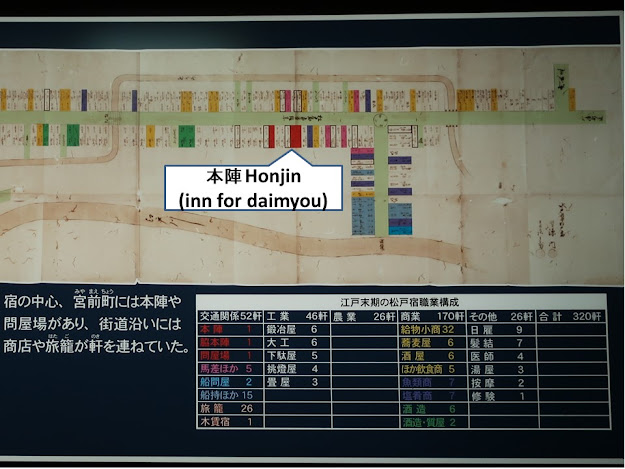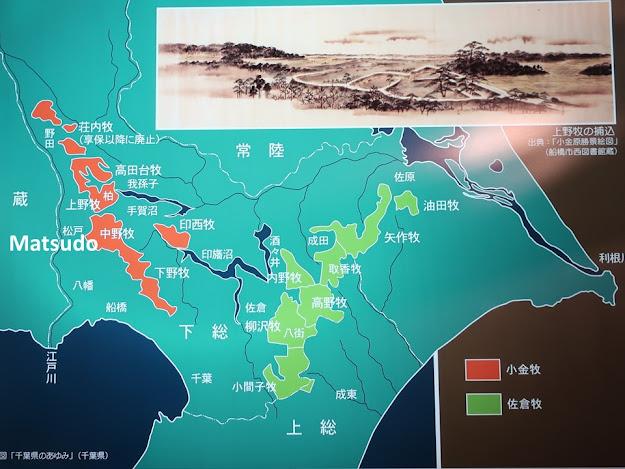My hometown Matsudo city is located in the east of Tokyo. It is
around 20km away from the central of Tokyo, Nihonbashi, so many people go there to work every day.
In the Edo period, there were post towns. At that time, people enjoyed joining the government events like horse and deer-hunting (O-shishigari) .
In the Edo period, there were post towns. At that time, people enjoyed joining the government events like horse and deer-hunting (O-shishigari) .
私の地元、東京の東隣の松戸市の博物館。人類の登場から昭和まで分かりやすく展示されている。松戸は平安時代までは歴史に残る物が少ないということで、武家の世の中から展示が充実し、江戸時代は野馬捕りやお鹿狩りをはじめ、民衆も参加した楽しいイベントが展示されていた。
Matsudo and Kogane post towns were in Matsudo city. These towns prospered
as the distribution centers.
Especially, Matsudo post was the base of the river traffic.
There were 320 houses in Matsudo post town including 30 inns and 8
sake(alcohol) brewers. There was a special inn called “Honjin”, and only daimyo lords could use it.
 |
| Matsudo post town、松戸宿 |
 |
| Matsudo port (1/100 model)、松戸の河岸(1/100模型) |
 |
Map of Matsudo post town in the end of the Edo period
松戸宿地図/江戸末期
|
松戸には水戸道中の二つの宿場松戸宿と小金宿があった。これらは流通経済の中心地としても発展した。特に、松戸宿は河川交通の基地にもなった。とある。松戸宿家並絵図(天保7年以降)。合計320軒で、酒造が8軒は多いと思う。宿は本陣を入れて30軒。
In Kogane post town, there was a large inn dedicated to
Mito-Tokugawa clan who were relatives of the shogun.
Map of Kogane post town、小金宿
|
 |
Procession of Mito-Tokugawa who was a
high-ranking daimyo
水戸徳川家大名行列模型(明治時代、旧徳川家蔵)
|
Trip of a farmer in Matsudo:
The
panel below shows the travel routes of Mr. Ookuma who was a farmer and also village head. He
traveled five times in 16 years since 1841, which was extraordinary. Because, during that time, people traveled less than once or twice in there lives.
The travel manual is exhibited. It would help travelers, especially farmers who traveled in the cold winter, because it was off-season for them. Practical outfits were important for them. Hoods and shoes were depicted below.
 |
| Travel manual (1810)、旅行用心集 |
Pillow
box for eight people is also exhibited. I guess this is for a group tour, which
was major in the Edo period. The inns didn't welcome a single traveler, because, if he/she died, the owner of the inn must treat them and notic their relatives.
Reference:
Kusatsu Inn Highroads Community Square
, many travel tools are exhibited.
松戸の名主の旅。大熊家の旅の記録。まあよく出かけているものだ。1841年からは16年間に五回の旅に出ている。旅は楽しい。
旅行用心集(1810年刊)。様々な頭巾や履物が書いてある。冬の旅が多い百姓向けのノウハウ書だろうか。8人用の箱枕は団体旅行用だろうか。当時、行き倒れの懸念から一人旅は少なかった。江戸時代にも旅行用具が沢山売り出されている。
参考:草津宿街道交流館 、旅の道具の展示が充実
Deer-hunting by the shogun お鹿狩り
There were horse stock farms of the shogun in this region.
The shogun held a deer-hunting event (O-shishigari) four times in this area. It
seemed to be a military practice more than an excursion.
松戸には、幕府直轄牧場があり、馬を育てるだけでなく、将軍が主催するお鹿狩りが4回行われた。行楽ではなく、旗本を引き連れた軍事演習のようだ。
 |
Map of the horse stack farms、将軍直轄の牧場
|
Reference: MatsudoMuseum (2) (Special exhibition of O-shishigari), Yoshino’s daily life 04, March in 1849 (嘉永2年)
 |
| Hunting ground of O-shishigari、御狩り場 |
 |
| Helpers (farmer)、百姓勢子 |
4回目のお鹿狩り(1849)は盛大で、旗本など武士2万人、百姓勢子が下総、上総、武蔵、常陸から10万人が参加したという。人々はこの大イベントの見物に出かけた。
参考:松戸市立博物館 (2)(お鹿狩りの企画展)、吉野家日記Yoshino’s daily life 04, March in 1849 (嘉永2年)
Temporary
bridge, which was built on the platform of 20 ships, linked Matsudo and Edo. The shogun’s
warship called Kirin was moored in case of emergency.
 |
| 3D theater of O-shikagari which is popular
among children 3D映像は子どもたちに人気 |
Horses in stock farms were captured every
spring. People went to see it, so it was a kind of shows. The ema board which
was offered to Kouya-kannon temple is very impressive. I enlarged the details.
年に一度、放牧している馬を捕る野馬捕り。見物している人々の様子が生き生きと描かれている。以下、拡大図。
 |
Ema board offered to
Kouya-kannon (copy)
幸谷観音野馬捕りの献額(1882、複製)
|
Everyone enjoyed it. 皆さん楽しんでいます。
Kou 講
The
hanging scroll and dish of Koushin-kou are shown below. It was mentioned on the caption,
“Villagers prayed for Kousin god every 60 days. They gathered at the designated
house and waited for the sunrise. They ate vegetable dishes and talked a lot. It
seemed to be a joyful event.
庚申講の掛け軸と料理。「60日に一度の庚申の日に庚申様を祀る。村では庚申講が結ばれ、当日には村人の中の当番の家に集まり夜明けを待つ庚申待を行った。精進料理を食べ、世間話をして過ごすなど、村の楽しい行事の一つだったようだ」とある。
江戸時代の松戸には多くの村があり、新田開発もしていたが、前期には村境争いも多かったことが示されている。楽しんでいただけではない。
Modern era (after the Meiji period) 明治以降
After
the shogun stepped down in 1868, Matsudo still flourished as a local political center.
将軍家が退いて、明治になった後も松戸は群都として栄えた。
Many housing complexes were built for the increasing commuters to Tokyo in 1960s, it was done under the government policy. People flowed in from rural areas. The full-scale room is exhibited.
増加する都内への通勤者のために、1960年代に建てられた常盤平団地の実物模型が展示されています。なつかしスポット。
Komuso-monk and Ichigakuji temple
虚無僧と一月寺のコーナー
Komuso were pilgrims who walked around Japan. Their head temple was
in Matsudo, however the religious sect was banned in 1871.
虚無僧の本拠は、松戸市小金にあったが、明治政府は普化宗を廃止した。一月寺は昭和に日蓮正宗の寺として再興された。
 |
| Komuso-monk、虚無僧 |
 |
Shakuhachi-recorder which Komuso played
虚無僧が持って巡礼する尺八
|
 |
| Shakuhachi-recorder and dancing、遊楽図屏風 |
This
museum is in a peaceful park.
The ramen event produced by the famous ramen shop
Tomita ( https://www.tomita-cocoro.jp/
) gathered a lot of people when I visited.
通常は静かな公園だが、この日は松戸の冨田が企画するラーメンなどのイベントで人がいっぱい。
7 funs(楽fun)were found. Visited in November, 2018
Official website : https://www.city.matsudo.chiba.jp/m_muse/index.html
(Japanese only), accessed in November,
2020
Previous post (Adventure of a charming British lady in the rural area of Japan):
Next post (Museum in the neighboring city):
Kamagaya museum 鎌ケ谷市郷土資料館
Kamagaya museum 鎌ケ谷市郷土資料館















Comments
Post a Comment